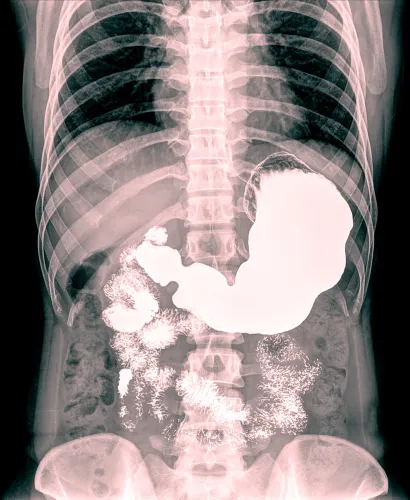Change Your Coding Mindset for Gastric Ulcers Under ICD-10

Chronicity and hemorrhage will outweigh obstructions in code choices.
When you report gastric ulcer diagnoses after ICD-10 goes into effect in October 2014, you won’t need to focus as much on obstructions. But you will need to concentrate on chronicity, along with presence or absence of hemorrhage and perforations.
Take Current Code Options to the 5th Digit
For gastric ulcer reporting in ICD-9, you begin with base code 531 (Gastric ulcer). Then, you assign a fourth digit expansion that explains the chronicity and presence or absence of perforation and hemorrhage. Your current choices include:
531.0 (Acute gastric ulcer with hemorrhage)
531.1 (Acute gastric ulcer with perforation)
531.2 (Acute gastric ulcer with hemorrhage and perforation)
531.3 (Acute gastric ulcer without mention of hemorrhage or perforation)
531.4 (Chronic or unspecified gastric ulcer with hemorrhage)
531.5 (Chronic or unspecified gastric ulcer with perforation)
531.6 (Chronic or unspecified gastric ulcer with hemorrhage and perforation)
531.7 (Chronic gastric ulcer without mention of hemorrhage or perforation)
531.9 (Gastric ulcer unspecified as acute or chronic without mention of hemorrhage or perforation).
Key: Each of the diagnoses further expands with a fifth digit to that notes the presence or absence of obstruction. For example, 531.0 expands into the following two codes:
531.00 (Acute gastric ulcer with hemorrhage without obstruction)
531.01 (Acute gastric ulcer with hemorrhage with obstruction).
Don’t Worry About Obstructions in ICD-10
When ICD-10 codes come into use, 531 in the ICD-9 code system will crosswalk to K25 (Gastric ulcer). The list of inclusions will add on acute erosion of the stomach, while exclusion lists will also comprise acute gastritis (K29.0-).
Vital: The presence or absence of obstruction will not be a factor when choosing the correct ICD-10 code. Chronicity and the presence or absence of perforation and hemorrhage, however, will still be essential.
K25 will further expand to the following nine codes, depending on the factors mentioned above:
K25.0 (Acute gastric ulcer with hemorrhage)
K25.1 (Acute gastric ulcer with perforation)
K25.2 (Acute gastric ulcer with both hemorrhage and perforation)
K25.3 (Acute gastric ulcer without hemorrhage or perforation)
K25.4 (Chronic or unspecified gastric ulcer with hemorrhage)
K25.5 (Chronic or unspecified gastric ulcer with perforation)
K25.6 (Chronic or unspecified gastric ulcer with both hemorrhage and perforation)
K25.7 (Chronic gastric ulcer without hemorrhage or perforation)
K25.9 (Gastric ulcer, unspecified as acute or chronic, without hemorrhage or perforation).
Capture These Details in the Documentation
Some symptoms that you are most likely to encounter in the patient documentation in a patient suffering from gastric ulcers include upper abdominal pain, vomiting, bloating, melena, weight loss, loss of appetite and hematemesis.
If the gastroenterologist suspects gastric ulcers based on the symptoms, he might order diagnostic examinations such as a barium upper gastrointestinal series. Or, he might choose to perform an upper gastroesophagoduodenoscopy (43235, Upper gastrointestinal endoscopy including esophagus, stomach, and either the duodenum and/or jejunum as appropriate; diagnostic, with or without collection of specimen[s] by brushing or washing [separate procedure]) and later perform a breath test for detection of H. pylori (83013, Helicobacter pylori; breath test analysis for urease activity, non-radioactive isotope [e.g., C-13] and 83014, Helicobacter pylori; drug administration).
Example: The gastroenterologist assesses the patient in his office and schedules an upper EGD at the outpatient center to ascertain the cause of the patient’s upper abdominal pain. During the EGD, the physician notes the presence of ulcers in the stomach with signs of hemorrhage and signs of previously formed ulcers that have now healed. He also notes that there are no signs of perforation or obstruction. He obtains a biopsy of the antrum which later reveals the presence of H. pylori infection.
Based on the symptoms, results of tests, and observations made during the EGD, the physician confirms a diagnosis of chronic gastric ulcer and prescribes therapy with a proton pump inhibitor medication and a course of antibiotics for the H. pylori infection.
Code it: You report the EGD with 43239 and the breath test with 83013. You report the diagnosis with 531.40 (Chronic or unspecified gastric ulcer with hemorrhage without obstruction) if you are using ICD-9 codes and K25.4 if you are using ICD-10 code sets. For the H. Pylori infection you report the diagnosis with 041.86 if you are using ICD-9 codes and B96.81 if you are using ICD-10 codes.

